

 61.
July 28, 1868: Another phase of creative photography is the challenge of
rescuing and preserving old prints and negatives made by other photographers.
A lot of people ask why I devote so much time to it. I get a great deal
of satisfaction in taking an obscure snapshot or faded print and bringing
out an image that is clearer and more detailed than the original. Sometimes
we're lucky enough to find an original glass plate negative. Even when
it's broken or cracked, I can usually work with it. This one was cracked,
but the emulsion was still intact. By fitting it snugly together on the
contact printer, I could make a print that barely shows the break. MSA
SC 1477-5938
61.
July 28, 1868: Another phase of creative photography is the challenge of
rescuing and preserving old prints and negatives made by other photographers.
A lot of people ask why I devote so much time to it. I get a great deal
of satisfaction in taking an obscure snapshot or faded print and bringing
out an image that is clearer and more detailed than the original. Sometimes
we're lucky enough to find an original glass plate negative. Even when
it's broken or cracked, I can usually work with it. This one was cracked,
but the emulsion was still intact. By fitting it snugly together on the
contact printer, I could make a print that barely shows the break. MSA
SC 1477-5938
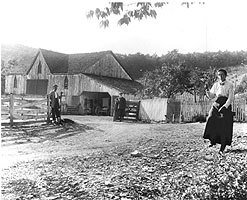 62.
1905 circa: Few photographers today can cope with old negatives, but my
early experience working with glass plates everyday taught me the corrections
necessary to make fine prints. This orthochromatic emulsion by C. D. Young
of Boonsboro, for example, is very subject to halation, therefore rendering
the sky greatly overexposed. To make a fully corrected print requires five
times the exposure in the sky than the subjects in the foreground need.
Because this was a 5x7 plate, I was able to work in the enlarger rather
than on a contact printer. MSA SC 1477-5356
62.
1905 circa: Few photographers today can cope with old negatives, but my
early experience working with glass plates everyday taught me the corrections
necessary to make fine prints. This orthochromatic emulsion by C. D. Young
of Boonsboro, for example, is very subject to halation, therefore rendering
the sky greatly overexposed. To make a fully corrected print requires five
times the exposure in the sky than the subjects in the foreground need.
Because this was a 5x7 plate, I was able to work in the enlarger rather
than on a contact printer. MSA SC 1477-5356
 63.
1905 circa: This is a fabulous study by C. D. Young of a family picking
berries near Boonsboro. You can read a lot into a picture like this. The
man is obviously the authority figure, standing upright and out in front.
His wife is almost hidden behind the bushes. One of his daughters is wearing
a prissy hat. Only the innocent child is not staring at the camera. It's
quite a statement. MSA SC 1477-5359
63.
1905 circa: This is a fabulous study by C. D. Young of a family picking
berries near Boonsboro. You can read a lot into a picture like this. The
man is obviously the authority figure, standing upright and out in front.
His wife is almost hidden behind the bushes. One of his daughters is wearing
a prissy hat. Only the innocent child is not staring at the camera. It's
quite a statement. MSA SC 1477-5359
 64.
1905 circa: This picture was taken by a doctor in New Market. It really
captures the essence of early American farming. If photographs like this
one hadn't survived, a scene like this could only be described in words.
This negative was very dense. The early rules of photography before light
meters required you to expose for the shadows and develop for the highlights.
This worked well when you had a contact printer, but today we work on double-condenser
enlargers and with thin films, which reverses those early principles. MSA
SC 1477-5849
64.
1905 circa: This picture was taken by a doctor in New Market. It really
captures the essence of early American farming. If photographs like this
one hadn't survived, a scene like this could only be described in words.
This negative was very dense. The early rules of photography before light
meters required you to expose for the shadows and develop for the highlights.
This worked well when you had a contact printer, but today we work on double-condenser
enlargers and with thin films, which reverses those early principles. MSA
SC 1477-5849
 65.
1891: Many glass plates are quite dirty when I get them. Cleaning them
is very meticulous and time-consuming work and should only be attempted
by a professional. When you have an 8x10 plate like this one of Baltimore
Street in Cumberland by Hervey Laney, there are real advantages. On a contact
printer you can use tissue paper and cotton on very small areas of the
negative to hold back or transmit light as needed. Sometimes this kind
of preparation takes hours, but once done, you can make as many matching
contact prints as desired. If you make a 4x5 copy negative from one of
the prints, you'll have a negative anyone can use to get a good print.
They won't have to know all these techniques. MSA SC 1477-6701
65.
1891: Many glass plates are quite dirty when I get them. Cleaning them
is very meticulous and time-consuming work and should only be attempted
by a professional. When you have an 8x10 plate like this one of Baltimore
Street in Cumberland by Hervey Laney, there are real advantages. On a contact
printer you can use tissue paper and cotton on very small areas of the
negative to hold back or transmit light as needed. Sometimes this kind
of preparation takes hours, but once done, you can make as many matching
contact prints as desired. If you make a 4x5 copy negative from one of
the prints, you'll have a negative anyone can use to get a good print.
They won't have to know all these techniques. MSA SC 1477-6701
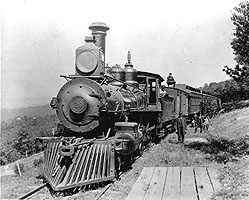 66.
1916 circa: This picture really helps you to experience the power of the
iron horse. You get a pretty good idea of what railroading was all about--there's
a strong likeness of the engineer, the brakeman, the passengers, all dominated
by the locomotive. When you enlarge a photograph like this, its impact
is heightened still more. With some pictures a small print is all you need,
but something like this cries out to be blown up big. MSA SC 1477-6016
66.
1916 circa: This picture really helps you to experience the power of the
iron horse. You get a pretty good idea of what railroading was all about--there's
a strong likeness of the engineer, the brakeman, the passengers, all dominated
by the locomotive. When you enlarge a photograph like this, its impact
is heightened still more. With some pictures a small print is all you need,
but something like this cries out to be blown up big. MSA SC 1477-6016
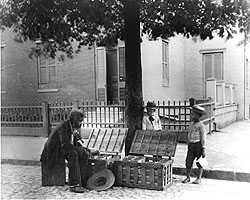 67.
1893: Frances Benjamin Johnston made this picture when she was in Annapolis
to photograph the Naval Academy. It's obviously a spontaneous shot since
none of the three figures is aware of the camera. This makes it very appealing
and shows that even with an 8x10 camera on a tripod you can still achieve
spontaneity. It just takes more discipline to do it that way. MSA SC 1477-3589
67.
1893: Frances Benjamin Johnston made this picture when she was in Annapolis
to photograph the Naval Academy. It's obviously a spontaneous shot since
none of the three figures is aware of the camera. This makes it very appealing
and shows that even with an 8x10 camera on a tripod you can still achieve
spontaneity. It just takes more discipline to do it that way. MSA SC 1477-3589
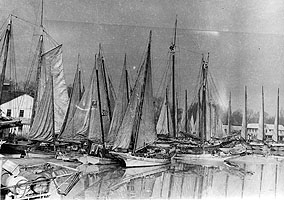 68.
1890 circa: We had the original film negative for this picture of oyster
boats in Cambridge Creek. It was rather flat, but by making a print on
polyfiber paper and using a high contrast filter, I was able to add zip
to the photograph. I actually used two and one-half times the contrast
I would need with a normal print. Then I copied that print onto 4x5 film
and overdeveloped the negative to further increase the contrast. Now, when
I make a print from my copy negative, I continue to increase the contrast
by using filters again. This is a rare case where you could say my copy
negative produces better prints than the original. MSA SC 1477-6597
68.
1890 circa: We had the original film negative for this picture of oyster
boats in Cambridge Creek. It was rather flat, but by making a print on
polyfiber paper and using a high contrast filter, I was able to add zip
to the photograph. I actually used two and one-half times the contrast
I would need with a normal print. Then I copied that print onto 4x5 film
and overdeveloped the negative to further increase the contrast. Now, when
I make a print from my copy negative, I continue to increase the contrast
by using filters again. This is a rare case where you could say my copy
negative produces better prints than the original. MSA SC 1477-6597
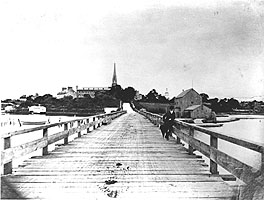 69.
1890 circa: This photograph makes such a strong statement about bygone
Annapolis that we selected it for the cover of The Train's Done Been
and Gone even before we really started assembling the book. Unfortunately,
we were working with a copy of a copy--a third generation photograph, at
least. After the book came out in 1976, Gilbert Moore brought me an album
of original photographs by Henry Schaefer and this picture was in it. The
new print was so sharp we could see strong detail everywhere in the picture.
When we reprinted the book in 1981, this was the only thing we replaced.
The new cover is ever so much better than the first edition. Our only regret
was that because of the layout, we had to crop out the horse manure. MSA
SC 985-28
69.
1890 circa: This photograph makes such a strong statement about bygone
Annapolis that we selected it for the cover of The Train's Done Been
and Gone even before we really started assembling the book. Unfortunately,
we were working with a copy of a copy--a third generation photograph, at
least. After the book came out in 1976, Gilbert Moore brought me an album
of original photographs by Henry Schaefer and this picture was in it. The
new print was so sharp we could see strong detail everywhere in the picture.
When we reprinted the book in 1981, this was the only thing we replaced.
The new cover is ever so much better than the first edition. Our only regret
was that because of the layout, we had to crop out the horse manure. MSA
SC 985-28
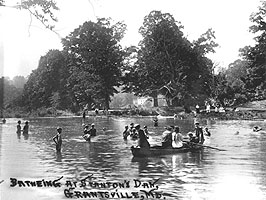 70.
1920 circa: Of all the early Maryland photographers whose work I have seen,
Leo Beachy had a sensitivity for human interest pictures that was unique.
His ability to capture the essence of a time and place is astounding; few
35mm photographers today are able to achieve photographs like his. I think
this phenomenon can only be explained by the fact that his subjects knew
him well and responded without concern for his camera. This is particularly
impressive when you know that he had a physical disability that required
someone to help him move from place to place, and to carry his heavy glass
plates and cumbersome view-camera. He often wrote captions right on the
negatives—which had to be done on the emulsion side--so he had to be good
at writing backwards. MSA SC 1477-5714
70.
1920 circa: Of all the early Maryland photographers whose work I have seen,
Leo Beachy had a sensitivity for human interest pictures that was unique.
His ability to capture the essence of a time and place is astounding; few
35mm photographers today are able to achieve photographs like his. I think
this phenomenon can only be explained by the fact that his subjects knew
him well and responded without concern for his camera. This is particularly
impressive when you know that he had a physical disability that required
someone to help him move from place to place, and to carry his heavy glass
plates and cumbersome view-camera. He often wrote captions right on the
negatives—which had to be done on the emulsion side--so he had to be good
at writing backwards. MSA SC 1477-5714
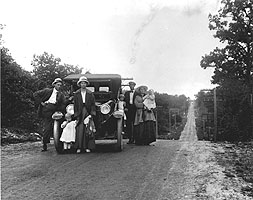 71.
1915 circa: This glass plate appeared almost blank when we saw it, and
it was yellow in color. Beachy obviously underexposed it, then intensified
it with pyro, which gave it the yellow appearance. To the uneducated it
seemed that there was very little image, but since photographic paper is
insensitive to yellow, there was more than enough contrast. MSA SC 1477-5733
71.
1915 circa: This glass plate appeared almost blank when we saw it, and
it was yellow in color. Beachy obviously underexposed it, then intensified
it with pyro, which gave it the yellow appearance. To the uneducated it
seemed that there was very little image, but since photographic paper is
insensitive to yellow, there was more than enough contrast. MSA SC 1477-5733
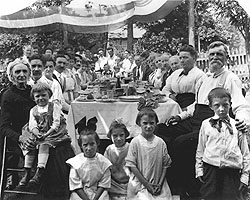 72.
1910 circa: People often question the serious expressions on the faces
in old photographs. A "portrait" like this was made on a glass plate negative
and required an exposure time of up to five seconds, so the people had
to pose for a long time. Beachy had to stop the lens way down to get this
much depth of field. I think this is a real study in human nature; the
various ages of the people makes this one of Beachy's most extraordinary
photographs. MSA SC 1477-5761
72.
1910 circa: People often question the serious expressions on the faces
in old photographs. A "portrait" like this was made on a glass plate negative
and required an exposure time of up to five seconds, so the people had
to pose for a long time. Beachy had to stop the lens way down to get this
much depth of field. I think this is a real study in human nature; the
various ages of the people makes this one of Beachy's most extraordinary
photographs. MSA SC 1477-5761
| The Eye of the Beholder | The War and Before |
| Sleepytime Annapolis | Annapolis in Blossom |
| The Chesapeake Bay | Vintage Photographs |
| Cityscape | About Maryland |
|
Tell Us What You Think About the Maryland State Archives Website!
|